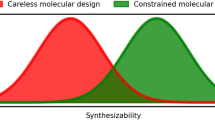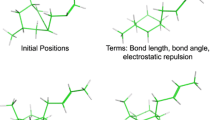Abstract
This paper investigates a computational procedure for the determination of the atom types on the vertices of a molecular skeleton to optimize interaction with the receptor site whilst maintaining a synthetically reasonable structure. The connectivity of the skeleton is analysed and appropriate atom types are compiled for each vertex. Receptor ionization and conformational states are generated by varying the positions of hydrogen atoms and electron lone pairs in the carboxyl, rotatable hydroxyl and amino groups. The structure is divided into small non-overlapping substructures. Atom types are assigned exhaustively onto each of the substructures using a depth-first search method; chemical rules are applied to reject unacceptable atom combinations early on. An empirical interaction score is calculated and the representatives of each partial structure are stored in ascending order according to their scores. The branch-and-bound procedure is then used to find the structures with the lowest scores. The method is illustrated using five protein–ligand complexes.
Similar content being viewed by others
References
Slater, P.E. and Timms, D., J. Mol. Graph., (1993) 248.
Verlinde, C.L.M.J. and Hol, W.G.J., Structure, 2 (1994) 577.
Lewis, R.A. and Leach, A.R., J. Comput.-Aided Mol. Design, 8 (1994) 467.
Lewis, R.A. and Dean, P.M., Proc. R. Soc. London, B236 (1989) 125.
Lewis, R.A. and Dean, P.M., Proc. R. Soc. London, B236 (1989) 141.
Todorov, N.P. and Dean, P.M., J. Comput.-Aided Mol. Design, 11 (1997) 175.
Chan, S.L., Chau, P.-L. and Goodman, J.M., J. Comput.-Aided Mol. Design, 6 (1992) 461.
Nakamura, H., Komatsu, K., Nakagawa, S. and Umeyana, H., J. Mol. Graph., 3 (1985) 2.
Chau, P.-L. and Dean, P.M., J. Comput.-Aided Mol. Design, 8 (1994) 513.
Chau, P.-L. and Dean, P.M., J. Comput.-Aided Mol. Design, 8 (1994) 527.
Chau, P.-L. and Dean, P.M., J. Comput.-Aided Mol. Design, 8 (1994) 545.
Barakat, M.T. and Dean, P.M., J. Comput.-Aided Mol. Design, 9 (1995) 341.
Barakat, M.T. and Dean, P.M., J. Comput.-Aided Mol. Design, 9 (1995) 351.
Barakat, M.T. and Dean, P.M., J. Comput.-Aided Mol. Design, 9 (1995) 359.
Barakat, M.T. and Dean, P.M., J. Comput.-Aided Mol. Design, 9 (1995) 448.
Barakat, M.T. and Dean, P.M., J. Comput.-Aided Mol. Design, 9 (1995) 457.
Chau, P.-L. and Dean, P.M., J. Comput.-Aided Mol. Design, 6 (1992) 385.
Chau, P.-L. and Dean, P.M., J. Comput.-Aided Mol. Design, 6 (1992) 397.
Chau, P.-L. and Dean, P.M., J. Comput.-Aided Mol. Design, 6 (1992) 407.
Gillet, V., Johnson, A.P., Mata, P., Sike, S. and Zsoldos, Z., J. Comput.-Aided Mol. Design, 7 (1993) 127.
Gillet, V., Newell, W., Mata, P., Myatt, G., Sike, S., Zsoldos, Z. and Johnson, A.P., J. Comput.-Aided Mol. Design, 7 (1993) 127.
Böhm, H.-J., J. Comput.-Aided Mol. Design, 8 (1994) 243.
Gray, N.A.B., Computer-Assisted Structure Elucidation, Chapter XI, pp. 399–455, John Wiley and Sons, New York, NY, 1986.
Morley, S.D., Abraham, R.J., Haworth, I.S., Jackson, D.E., Saunders, M.R. and Vinter, J.G., J. Comput.-Aided Mol. Design, 5 (1991) 475.
Nilsson, N.J., Principles of Artificial Intelligence, Springer-Verlag, Berlin, 1982.
Bernstein, F.C., Koetzle, T.F., Williams, G.J.B., Meyer, E.F., Brice, M.D., Rodgers, J.R., Kennard, O., Shimanouchi, T. and Tasumi, M., J. Mol. Biol., 112 (1977) 535.
Press, W.H., Flannery, B.P., Teukolsky, S.A. and Vetterling, W.T., Numerical Recipes: The Art of Scientific Computing, Cambridge University Press, Cambridge, 1986.
Marquart, M., Walter, J., Deisenhofer, J., Bode, W., Huber, R., Acta Crystallogr. B, 39 (1983) 480.
Mares-Guia, M. and Shaw, E., J. Biol. Chem., 240 (1965) 1579.
Cowan, S.W., Newcomer, M.E. and Jones, T.A., Proteins, 8 (1990) 44.
Bolin, J.T., Filman, D.J., Matthews, D.A., Hamlin, R.C. and Kraut, J., J. Biol. Chem., 257 (1982) 13650.
Matthews, B.W., Acc. Chem. Res., 21 (1988) 333.
Bone, R., Vacca, J.P., Anderson, P.S. and Holloway, M.K., J. Am. Chem. Soc., 113 (1991) 9382.
Dean, P.M., In Dean, P.M. (Ed.) Molecular Similarity in Drug Design, pp. 1–23, Blackie Academic and Professional, Cambridge, 1995.
Ihlenfeldt, W.D., Takahashi, Y., Abe, H. and Sasaki, S., J. Chem. Inf. Comput. Sci., 34 (1982) 109.
Author information
Authors and Affiliations
Rights and permissions
About this article
Cite this article
Todorov, N., Dean, P. A branch-and-bound method for optimal atom-type assignment in de novo ligand design. J Comput Aided Mol Des 12, 335 (1998). https://doi.org/10.1023/A:1007994827087
Issue Date:
DOI: https://doi.org/10.1023/A:1007994827087




